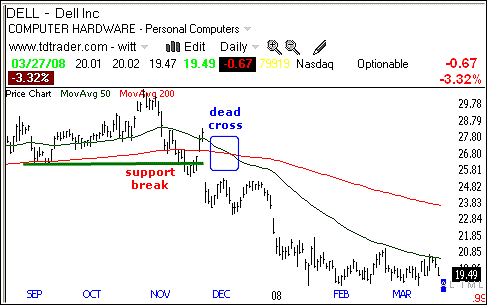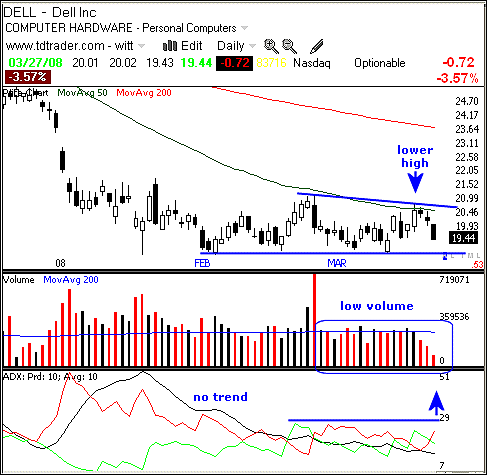
HOT TOPICS LIST
- MACD
- Fibonacci
- RSI
- Gann
- ADXR
- Stochastics
- Volume
- Triangles
- Futures
- Cycles
- Volatility
- ZIGZAG
- MESA
- Retracement
- Aroon
INDICATORS LIST
LIST OF TOPICS
PRINT THIS ARTICLE
by Arthur Hill
Dell Computer consolidated after a sharp move down, and the components of the average directional movement index can be used to identify a breakout.
Position: Hold
Arthur Hill
Arthur Hill is currently editor of TDTrader.com, a website specializing in trading strategies, sector/industry specific breadth stats and overall technical analysis. He passed the Society of Technical Analysts (STA London) diploma exam with distinction is a Certified Financial Technician (CFTe). Prior to TD Trader, he was the Chief Technical Analyst for Stockcharts.com and the main contributor to the ChartSchool.
PRINT THIS ARTICLE
ADXR
Dell Consolidates Before Next Move
03/27/08 02:30:34 PMby Arthur Hill
Dell Computer consolidated after a sharp move down, and the components of the average directional movement index can be used to identify a breakout.
Position: Hold
| Figure 1 shows the long-term picture for Dell (DELL). The stock broke down in November 2007 with a big support break. The 50-day moving average crossed below the 200-day moving average in December and both moving averages are moving lower. The big trend is clearly down and this favors further weakness. |

|
| FIGURE 1: DELL, DAILY. In this long-term view of Dell, the stock broke down in November with a big support break. |
| Graphic provided by: TeleChart2007. |
| |
| DELL found support in early February 2008 and consolidated the last two months. Is this consolidation a base building exercise or simply a rest in the overall downtrend? Let's look at the pattern and then the average directional movement index (ADX). On the price chart, DELL established support at 19 with lows in February and March. A lower high formed in late March and a descending triangle could be taking shape (Figure 2). A move below 19 would confirm this pattern and signal a continuation lower. Conversely, a break above 21 on good volume would show strength and point to higher prices. |
| The bottom indicator window shows the ADX. The ADX is black, positive direction (+DI) is green and negative direction (-DI) is red. The ADX is trading at its lowest point in months and this shows little direction. In other words, it confirms the consolidation or flat trading over the last few months. |

|
| FIGURE 2: DELL, DAILY. A lower high formed in late March, and a descending triangle could be taking shape. |
| Graphic provided by: TeleChart2007. |
| |
| The directional indicators have also been flat, as neither the bulls nor the bears can get the upper hand. The blue horizontal line in Figure 2 shows resistance for +DI and -DI. The one that breaks resistance can be used to trigger the next signal. An upside breakout in +DI would be bullish, while an upside breakout in -DI would be bearish. This could be used to confirm a consolidation break and trade in the direction of that break. |
Arthur Hill is currently editor of TDTrader.com, a website specializing in trading strategies, sector/industry specific breadth stats and overall technical analysis. He passed the Society of Technical Analysts (STA London) diploma exam with distinction is a Certified Financial Technician (CFTe). Prior to TD Trader, he was the Chief Technical Analyst for Stockcharts.com and the main contributor to the ChartSchool.
| Title: | Editor |
| Company: | TDTrader.com |
| Address: | Willem Geetsstraat 17 |
| Mechelen, B2800 | |
| Phone # for sales: | 3215345465 |
| Website: | www.tdtrader.com |
| E-mail address: | arthurh@tdtrader.com |
Traders' Resource Links | |
| TDTrader.com has not added any product or service information to TRADERS' RESOURCE. | |
Click here for more information about our publications!
Comments
Date: 03/30/08Rank: 5Comment:

|

Request Information From Our Sponsors
- StockCharts.com, Inc.
- Candle Patterns
- Candlestick Charting Explained
- Intermarket Technical Analysis
- John Murphy on Chart Analysis
- John Murphy's Chart Pattern Recognition
- John Murphy's Market Message
- MurphyExplainsMarketAnalysis-Intermarket Analysis
- MurphyExplainsMarketAnalysis-Visual Analysis
- StockCharts.com
- Technical Analysis of the Financial Markets
- The Visual Investor
- VectorVest, Inc.
- Executive Premier Workshop
- One-Day Options Course
- OptionsPro
- Retirement Income Workshop
- Sure-Fire Trading Systems (VectorVest, Inc.)
- Trading as a Business Workshop
- VectorVest 7 EOD
- VectorVest 7 RealTime/IntraDay
- VectorVest AutoTester
- VectorVest Educational Services
- VectorVest OnLine
- VectorVest Options Analyzer
- VectorVest ProGraphics v6.0
- VectorVest ProTrader 7
- VectorVest RealTime Derby Tool
- VectorVest Simulator
- VectorVest Variator
- VectorVest Watchdog
